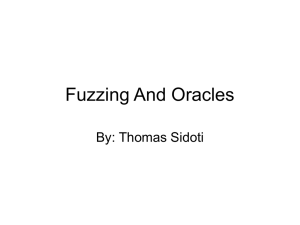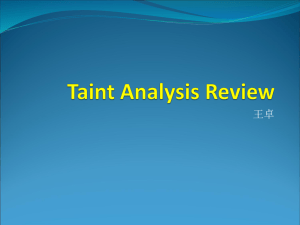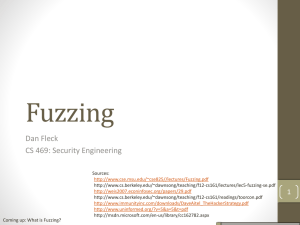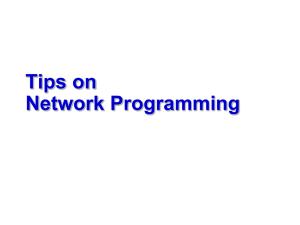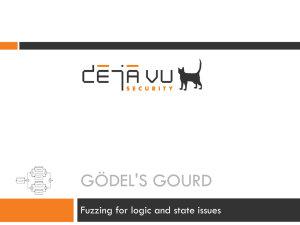GRAPE: Generative Rule-based Generic Stateful
advertisement
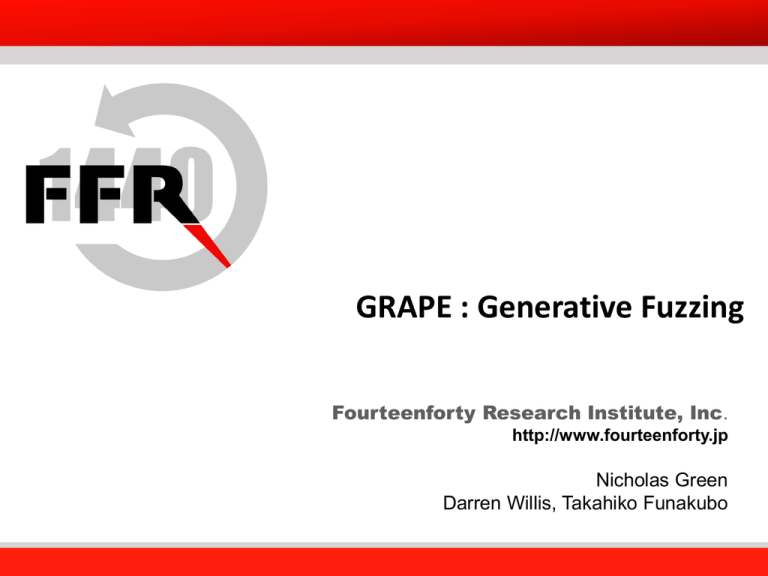
Fourteenforty Research Institute, Inc.
GRAPE : Generative Fuzzing
Fourteenforty Research Institute, Inc.
Fourteenforty Research Institute, Inc.
http://www.fourteenforty.jp
Nicholas Green
Darren Willis, Takahiko Funakubo
1
Fourteenforty Research Institute, Inc.
Grape
A Generative Fuzzer
– Inspired by Scapy , Sulley, PeachFuzz, et cetera
– Generalized Fuzzing: can fuzz packets, files, higher level
interactions
– Handles responses: can interact with stateful protocols
– A product in development
2
Fourteenforty Research Institute, Inc.
Outline
•
•
•
What is fuzzing (very briefly)
– Types of fuzzing
– Challenges in fuzzing
Our fuzzer (GRAPE)
– Overview of a fuzzing ‘scenario’
– How GRAPE specifies its rules
– How GRAPE handles complex logic (macros)
– How GRAPE handles statefulness and participates in ‘conversations’
Demo
– Grape vs Windows 7
– Grape vs a router
3
Fourteenforty Research Institute, Inc.
Fuzzing: most basic case
Normal Data
System
Under
Test
Normal response
Abnormal data
Normal Data
Problem found
No normal response
4
Fourteenforty Research Institute, Inc.
Fuzzing (Very Much In Brief)
• Testing a system by subjecting it to malformed inputs
• Broadly, two types
– Mutating - Take existing inputs, tweak them
– Random Bit Flipping
– Field alteration (requires knowledge of fuzzed
format)
– Input samples important
– Generative - Use set of rules to create new inputs
– Also requires knowledge of fuzzed format
– Rules determine coverage
5
Fourteenforty Research Institute, Inc.
Fuzzing steps
• Find or define attack surface
• Generate Input Cases
• Feed Them To Target
• Monitor For Crashes / Unusual Behaviour
• Collect & Analyse Crash Data
6
Fourteenforty Research Institute, Inc.
Fuzzers - Generality
• Most fuzzers are quite specific
– Fuzzers for various protocols
• SNMP/DHCP/ICMP/etc
– Fuzzers for specific file formats
• PDF/HTML/SWF/etc
Scapy is an example of a more general fuzzing system, but still
network focused.
7
Fourteenforty Research Institute, Inc.
Fuzzers - Smartness
• Fuzzers vary in ‘randomness’
• Most fuzzers are smart
– Requires understanding the format of the input being
fuzzed
– Mutate/Generate input such that it’s likely to break the
system (length fields, etc)
Generally: Try to imagine how someone would have messed
up trying to implement the code parsing the input you’re
attacking.
8
Fourteenforty Research Institute, Inc.
Statefulness
• Sometimes protocols requiring keeping state
• A particular problem for generative fuzzers (mutative fuzzers
can usually playback their inputs)
• Need to incorporate responses from target into future fuzz
cases
• Examples
– Fuzzing an FTP server’s command line parsing
– Fuzzing a TCP implementation (sequence and
acknowledgement numbers)
9
Fourteenforty Research Institute, Inc.
Grape
•
•
•
•
•
•
Generative Fuzzer
Handles responses for stateful fuzzing
Rules for generation written in a YAML-like dialect
Compose rules into fuzz scenarios with Scapy-like syntax
Pluggable backends – output can be to file, network, etc
Sensible default low-level protocols – fuzz HTTP without
fuzzing (or thinking about) IPv4
• Heartbeat-based monitoring
• No crash data collection yet
10
Fourteenforty Research Institute, Inc.
Scenario
Config
Heartbeat
Fuzzing
Group
Group
11
Fourteenforty Research Institute, Inc.
Scenario
Config
Heartbeat
Fuzzing
Group
Group
Configuration for this
scenario.
E.g. setting a path and
low layer.
Example:
config {
rule_path: http/
low_layer: ether/ipv4/tcp
}
12
Fourteenforty Research Institute, Inc.
Scenario
Config
Heartbeat
Fuzzing
Group
Group
Monitor the target with a
“heartbeat”
Example:
heart_beat {
group {
send: http_head
recv: recv_http_head
}
}
13
Fourteenforty Research Institute, Inc.
Scenario
Config
Heartbeat
Fuzzing
Group
Group
The “fuzzing” category
describes a set of
“groups” which control the
real fuzzing
fuzzing {
group {
…
}
group {
…
}
}
14
Fourteenforty Research Institute, Inc.
Scenario
Config
A group describes a
“conversation” or series
of generations.
Heartbeat
Fuzzing
Group
Group
Example:
group {
send: http_init
recv: recv_basic
send: tricky_stuff
}
15
Fourteenforty Research Institute, Inc.
Group
Packet Description
Rule
Rule
Packet Description
Rule
A packet description is
one “send” or “receive”
line from the groups:
Example:
send: http_init
Rule
16
Fourteenforty Research Institute, Inc.
Group
Packet Description
Rule
Rule
Packet Description
Rule
Rule
A rule describes how an actual
input or series of inputs is created
(this is the generative bit!):
Example:
mostly_harmless:
method/s: ["GET", "PUT"]
space/s: " "
path/s: ["/index.html", "/“]
http/s: " HTTP/1.1\r\n"
done/s: "\r\n"
17
Fourteenforty Research Institute, Inc.
Simple Interactions
send: send this to (network/ a file)
recv: Receive this response (network only for now)
recv rules match the incoming data with certain rules
–If no match, skips to next fuzzing fuzzing case
Note: no ‘real’ flow control
–Use several groups, instead
18
Fourteenforty Research Institute, Inc.
Packet Structure Description
Here’s where we took inspiration from Scapy
There’s ‘layers’
ether/ipv4/tcp(syn:1)/payload(data:”AAAAA”)
‘/’ separates layers, parentheses allow overwriting of named
values inside the ‘rules’
‘sublayers’ can be placed in parentheses
ether/ipv6(routing(type:0))/udp/random(50)
19
Fourteenforty Research Institute, Inc.
Rule Definitions
The structures of generated inputs are composed
from ‘rules’ These rules are defined in separate files.
YAML-inspired syntax, but not really YAML
A Rule:
gif_basic:
signature/s3
version/s3
logical_screen_width/I2
logical_screen_height/I2
global_color_table_flag/b1
color_resolution/b3
:
:
:
:
:
:
"GIF"
["89a","87a"]
32
52
1
7
20
Fourteenforty Research Institute, Inc.
Primitive Definitions II
version/s3: ["89a","87a"]
Primitives are given by name, followed with a type and a length,
and then possible values for that primitive to take.
These values are automatically used in fuzzing.
Type is one of:
I: Big Endian Integer (that’s a capital i)
i: Little Endian Integer
S: Symbol
s: String
B: Binary
b: Bitfield
Lengths are in bytes, except for bitfields, where they are in
bits.
21
Fourteenforty Research Institute, Inc.
Rule Definitions
The structures of generated inputs are composed
from ‘rules’ These rules are defined in separate files.
YAML-inspired syntax, but not really YAML
A Rule:
gif_basic:
signature/s3
version/s3
logical_screen_width/I2
logical_screen_height/I2
global_color_table_flag/b1
color_resolution/b3
:
:
:
:
:
:
"GIF"
["89a","87a"]
32
52
1
7
22
Fourteenforty Research Institute, Inc.
Fuzzing Combinations
Fields like version/s3: ["89a","87a"] with multiple values
are automatically fuzzed by the fuzzing engine.
Output is generated such that every value given for a field is
present at least once in the output. One field per output is
‘fuzzed’; that field is iterated over. All others take their leftmost
value.
Fuzzing is not combinatorial, however:
version/s3: [“A",“B"]
width/I2: [1, 2, 3]
produces 4 combinations:
(“A”, 1) (“B”,1) (“A”, 2) (“A”, 3)
23
Fourteenforty Research Institute, Inc.
Combinatorial fuzzing
• We can also have fields that we want to fuzz as a
“combination”. i.e. This Rule:
CombinationMultiFieldFuzz:
value1%combo1/s1: [“A” , “B”]
value2%combo1/I1: [1, 2, 3]
Produces the following 6 combinations:
(“A”, 1) (“B”,1) (“A”, 2) (“B”, 2”) (“A”, 3) (“B”, 3)
24
Fourteenforty Research Institute, Inc.
Response Definitions
Responses are matched against response rules. These are similar
to the generation rules. Specifying a value indicates that part of
the response should match that value.
_ is “Don’t care”, and matches anything
Can also capture values using $() syntax:
recv_tcp:
src/i2 : _
dest/i2 : _
seqno/I4: $(sequence_number)
Captured values are available as variables.
25
Fourteenforty Research Institute, Inc.
Response Definitions II - Regexes
Response Definitions can include simplified regexps for string
matching
HTTP:
response: [“%s %d %s\r\n”,
$(version), $(code),
$(status)”]
These are powered by Oniguruma; the results of the scanf –style
capture directives get saved to corresponding variables.’
Real regexes can also be used for more power (i.e. non-scanfstyle).
26
Fourteenforty Research Institute, Inc.
Response Definitions III
Primitives in responses can be marked with an asterisk ‘*’ to
indicate 0 or more of the primitive should be matched.
Useful for matching higher-level patterns:
HTTP:
header-line/s*: “%s\r\n”
cache-expires/s: “EXPIRES blah blah \r\n”
header-line/s*: “%s\r\n”
done/s: “\r\n”
This matches an expires line at any point in the header
27
Fourteenforty Research Institute, Inc.
Variables
tcp:
srcport/I2: 0
dstport/I2: $tcp_dst_port
…
The syntax ‘$tcp_dst_port ‘ inserts the value of a variable
named ‘tcp_dst_port’.
Variables can be set by the user initially, captured from incoming
packets, or calculated by macro statements.
28
Fourteenforty Research Institute, Inc.
Symbols
• Symbols go inside <angle_brackets>
• Similar to variables but for internal use within the rules.
• Get substituted like rules
fuzzable_thing:
type%comb/i1 : [0,1,2,3, 256]
length%comb/i1 : [1,127, 128, 255, 256, 32767, 32768, 65535, 65536]
data%/comb/B : $repeat(<padding>, ($ivalue(<length>) + 1) / 2)
padding:
data1%comb/I1 : [0,1,2,3,4]
data2%comb/I1 : [0,1,2,3,4]
29
Fourteenforty Research Institute, Inc.
Macros
ipv4[6]:
version/b4
header_length/b4
dscp_or_tos/S
packet_length/I2
:
:
:
:
4
[($ilength(<ipv4>) -$ilength(<payload>)) / 4, 0, 15]
[ <tos>, <dscp> ]
[$ilength(<ipv4>), 1, 16, 32]
Various macros are provided, e.g. $ilength(<symbol>)
Arithmetic permitted – header_length can be the length of the
whole ipv4 block, minus the length of the payload block, divided
by 4.
Other macros include $tcp_checksum, $md5, $repeatA
30
Fourteenforty Research Institute, Inc.
Macro Example
void Macros::macro_irandom(Field *f, Var &out,
int argc, Var *argv)
{
int ret = rand();
out.setInteger(ret);
}
The macro interface is still work-in-progress.
Var types hold values used during generation; the result of a
macro can be set by calling ‘setInteger’, ‘setString’, etc, on
the ‘out’ argument of the macro.
argv is an array of argc pointers to Vars.
31
Fourteenforty Research Institute, Inc.
Backends
How the generated data is actually used.
Currently Provided:
Raw-Ethernet IPv4 IPv6 UDP TCP HTTP File
Lower level network backends use raw sockets and libpcap
Higher level network backends use OS provided sockets
32
Fourteenforty Research Institute, Inc.
Multiple Backends
Backends can be named
command: ether/ipv4/tcp
data: ether/ipv4/tcp(tcp_dst_port: 20)
Packets can be sent to any named backend
send(command): ftp/login(uname: ”foo”, pword: “bar”)
send(data): ftp/payload(data: “hogehogehoge”)
Sent to default(first) backend if no name specified.
Connection-based backends automatically opened on first send
33
Fourteenforty Research Institute, Inc.
Monitoring
• Currently an optional ‘heartbeat’ can be defined
• Detects when the target stops responding
• Usually, ICMP or ICMPv6 Echo Requests (pings)
• Can specify heartbeat interval (once every n packets)
34
Fourteenforty Research Institute, Inc.
HeartBeat
heart_beat {
group {
send: ipv4/icmp(icmp_echo_req)
recv: recv_ipv4/recv_icmp(recv_icmp_echo)
}
}
The monitoring heartbeat is specified like any other fuzzing rule.
Heartbeat can have a different backend.
35
Fourteenforty Research Institute, Inc.
Example – IPv6 Fuzzing
ipv6:
version/b4
trafficclass/b8
flowlabel/b20
packet_length/I2:
next_header/I1
hoplimit/I1
src_address/B16
dest_address/B16
headers/S
payload/S
: 6
: 0
: 0
$ilength(<payload>) + $ilength(<headers>)
: $id(<next>)
: [127, 255, 0]
: $ipv6_addr($ipv6_src)
: $ipv6_addr($ipv6_dst)
: <next_sublayer>
: <next_layer>
Generates an IPv6 header, and continues into the extension headers.
36
Fourteenforty Research Institute, Inc.
IPv6 Fuzzing - contd
For IPv6, instead of fuzzing values we fuzz structures Various combinations of chains of extension headers and
associated options:
send:
send:
send:
send:
ipv6(hopbyhop(home_address/quick_start)/routing/esp)/tcp
ipv6(hopbyhop(home_address/endpoint_ID)/routing/esp)/tcp
ipv6(hopbyhop(home_address/tunnel_limit)/routing/esp)/tcp
ipv6(hopbyhop(home_address/router_alert)/routing/esp)/tcp
Of course, these are generated by a script.
37
Fourteenforty Research Institute, Inc.
Example: TCP Fuzzing
tcp[0x6]:
srcport/I2: 0
dest/I2: $tcp_dst_port
seqno/I4: 0
ackno/I4: 0
dataoff/b4: ($ilength($<opts>) / 4) + 5
reserved/b4: 0
cwr/b1: 0
ece/b1: 0
urg/b1: 0
ack/b1: 0
… etc.
TCP control bits can be set using overwrites in the scenario file.
38
Fourteenforty Research Institute, Inc.
TCP Scenario Excerpt
group{
send: tcp(seqno:1747422, srcport: 6295, syn: 1, cwr:1, ece:1)
recv: recv_tcp
send: tcp(seqno:$recv_ack, srcport: 6295, ack: 1, ackno: $recv_seq + 1 ,
cwr:1, ece:1)
recv: recv_tcp
send: tcp(seqno:1747423, srcport: 6295,cwr:1, ece:1)/tcp_payload
recv: recv_tcp
send: tcp(seqno:1747449, srcport: 6295,fin: 1, cwr:1, ece:1)/tcp_payload
}
Scenario file uses overwrites to control the higher-level
behaviour to comply with the TCP protocol.
39
Fourteenforty Research Institute, Inc.
Demo One – IPv6
• Quick ipv6 fuzzing demo against Windows 7
40
Fourteenforty Research Institute, Inc.
Demo Two: Router
• DoS
41
Fourteenforty Research Institute, Inc.
Limitations
• Speed
– Research quality code
• Expressiveness
– Flow Control in scenarios
Small set of backends at present
42
Fourteenforty Research Institute, Inc.
Future Work
•
•
•
•
Speediness
Flow Control
More Backends
Macro programming for everyone
– Scripting language
• More sophisticated monitoring
– Likely requires cooperation with vendors for embedded
devices
– Develop a protocol?
• More file-oriented fuzzing support (spawning processes to
open generated files, etc)
43
Fourteenforty Research Institute, Inc.
Word
Fourteenforty Research Institute, Inc.
http://www.fourteenforty.jp
Nicholas Green
green@fourteenforty.jp
44
Fourteenforty Research Institute, Inc.
Thank you!
Questions?
Fourteenforty Research Institute, Inc.
http://www.fourteenforty.jp
Nicholas Green
green@fourteenforty.jp
45

